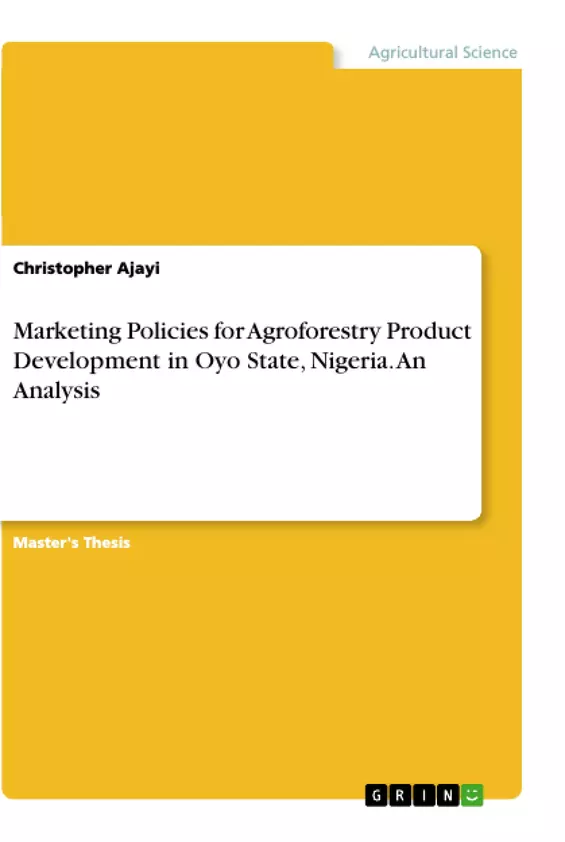The study will focus on Marketing policies influences on Agroforestry product development in Oyo State with a view to developing this sector of the state economy. In 1899, the first forest reserve in Nigeria named Gambari Forest Reserve was constituted and located in the Oyo State. The study was carried out to analyse marketing policies for Agroforestry product development in three purposively selected Local Government Areas (LGAs) of Akinyele, Oluyole and Ogbomosho in Oyo State, Nigeria.
In 1985, Abu found out that agroforestry practice in Gambari forest reserve Area of Oyo State Nigeria provided an annual income of N941.55 per farm. Although, conflicts do come between cultivating trees and raising agricultural crops, many agroforestry system allow farmers to integrate trees in to their farming systems and in some cases the trees increase overall farm productivity. But regrettably economic policy still discriminates seriously against agriculture and forestry in most developing countries by shifting the domestic terms of trade against the sector. What this does is to cause farmers and policy makers a like to undervalue the land and other natural resources. It is no wonder, then, that farmers do not attempt to develop their productive potential instead set out to mine them and move on (shifting cultivation).
Similarly, government interventions in provision of agroforestry products negates market emergence: the consequences of these policies should be high on our research agenda. It was not until the late 1990 that the Government farmer’s orgnisation and private sector together established a new quality modus operandi. Nigeria has now been attracted to the concept of adding value to its cocoabean by processing them locally for export as butter, cake and powder. Several factories were built often with loans or help in form of export subsidies from countries supplying the equipment. One operates successfully under the previous Marketing Board but many failed, not least because of their inherent dependence on subsidies. Apart from this, products of agroforestry system has been the major source of sustainability for both rural and urban markets. It is therefore pertinent to develop measures that will further enhance them.
Inhaltsverzeichnis (Table of Contents)
- CHAPTER ONE
- CHAPTER TWO
- CHAPTER THREE
- CHAPTER FOUR
- CHAPTER FIVE
- CHAPTER SIX
Zielsetzung und Themenschwerpunkte (Objectives and Key Themes)
This dissertation aims to analyze marketing policies for Agroforestry product development in Oyo state, Nigeria. It focuses on understanding the relationship between marketing policies and the successful development of these products.
- Impact of marketing policies on Agroforestry product development
- Analysis of factors affecting Agroforestry product development
- Challenges and opportunities in the distribution of Agroforestry products
- Role of middlemen in the distribution of Agroforestry products
- Recommendations for legislative changes to encourage Agroforestry product development
Zusammenfassung der Kapitel (Chapter Summaries)
- Chapter One provides an introduction to the study, outlining its objectives, scope, and research methodology.
- Chapter Two delves into the theoretical framework underpinning the study, reviewing relevant literature on marketing policies and Agroforestry product development.
- Chapter Three presents the research methodology, including the study area, data collection methods, and data analysis techniques.
- Chapter Four analyzes the findings of the study, exploring the relationship between marketing policies and Agroforestry product development.
- Chapter Five discusses the major factors affecting Agroforestry product development, including challenges related to storage, transportation, finance, and pest control.
Schlüsselwörter (Keywords)
The primary keywords and focus topics of this dissertation include Agroforestry, marketing policies, product development, distribution channels, middlemen, storage facilities, rural road networks, financial incentives, pest control, and legislation. The study explores the impact of these factors on the development and marketing of Agroforestry products in Oyo State, Nigeria.
- Citation du texte
- Christopher Ajayi (Auteur), 2005, Marketing Policies for Agroforestry Product Development in Oyo State, Nigeria. An Analysis, Munich, GRIN Verlag, https://www.grin.com/document/1141516



